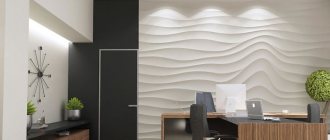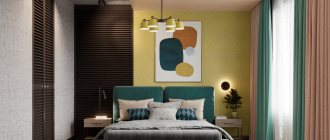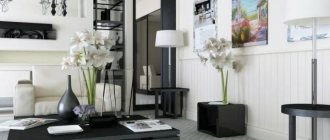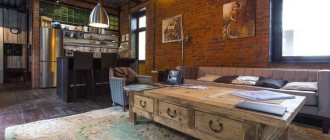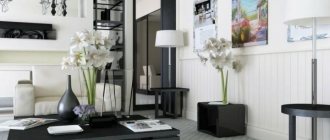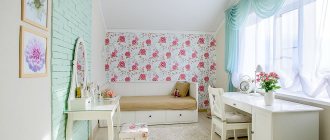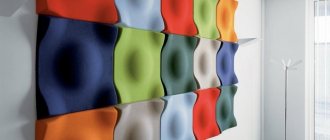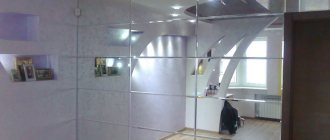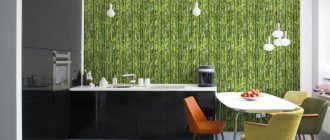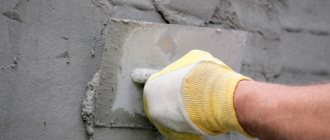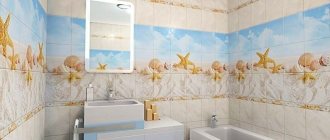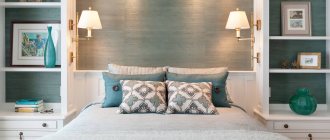Decorative panels are not just a trendy technique for transforming the interior, but also a convenient and practical solution that will help you create a beautiful interior decoration without any problems. Especially if you use 3D panels.
Various variations of design and material help to use it in rooms of any shape, size and purpose - kitchen, bathroom, bedroom.
Types of wall panels
Panels for decorating your home can be selected to suit every taste. Their main difference is the material from which they were made. On this basis they are divided into artificial, natural and combined wall panels. The material can be selected based on your goals and needs.
Natural material panels are made from veneer, solid wood, glass, metal such as aluminum and gypsum. There are also stone panels. They look very beautiful and expensive in the interior.
Artificial panels are made of plastic, PVC (polyvinyl chloride) and PU (polyurethane). They conquer with affordable prices.
By combined we mean wall panels that are made of chipboard (chipboard), laminated chipboard (laminated chipboard) and MDF (medium density fiberboard)
First, let's get acquainted with natural and environmentally friendly materials, and then move on to artificial and combined ones.
Characteristics and scope of application by type of material
We won’t talk about PVC panels. There is a separate article about them with a detailed description of the technology for mounting on walls and ceilings. In this paragraph, we will consider wall panels for interior decoration made from other materials. There are more than enough of them. There are the usual MDF and chipboard, there are exotic bamboo, glass, and metal.
Wall decoration with decorative panels is becoming increasingly popular
Tree
An excellent solution for those who value the environmental friendliness of the material, but it is worth remembering that wood requires special care so that the panels serve you as long as possible.
This type of coating will look quite organic in country or Provence style interiors. The panels will also look stylish in more modern styles - it all depends on the decor you choose.
Bamboo
Suitable for you if you like ethnic style, for example, Chinese or African. Expensive and rarely found in interiors.
They will perfectly convey the atmosphere of the East in your home if you are a connoisseur of such decor.
Glass
There is no need to be afraid of the fragility of this material, because modern technologies make it possible to produce panels of special strength.
Glass coating has only recently begun to be used for decoration, so it looks unusual and new, especially in minimalist and high-tech interiors.
In addition, glass panels are resistant to moisture or high temperatures, which is ideal for decorating the kitchen area, bathroom and more.
In the kitchen you can use a glass panel with a pattern; some designers use it as an apron.
Installation and operation of decorative panels in damp and warm rooms
Inexperienced craftsmen often make mistakes when finishing rooms such as a kitchen, bathroom or toilet, using materials that cannot withstand a humid atmosphere. Yes, this is not surprising. After all, in stores, some unscrupulous sales assistants resort to deception in order to increase sales. And even experienced people are often faced with the fact that instead of moisture-resistant material they are trying to sell them the most common and cheap one.
A bathroom in dark colors is a rather unusual solution
Let’s now try to figure out how not to fall for the bait of such businessmen, so that in the future you won’t bite your elbows looking at damaged walls in the bathroom or kitchen.
First you need to decide in which room the finishing will be done. After all, moisture in the bathroom is one thing, but temperature and steam from the hob in the kitchen are completely different. Naturally, we immediately reject natural wood, chipboard and fiberboard. You can also set aside plaster, which absorbs a lot of moisture. This leaves only two materials that can be used in such premises - glass and plastic. It is their characteristics that we will now consider in more detail.
Decorating the walls of the bathroom and toilet - which panels to choose?
Of course, in such rooms you need a material that will not absorb moisture. And the most convenient for this parameter will be PVC or plastic. In addition, there are places in the bathroom where decorative wall decoration is useless and this should also be taken into account. After all, in this case you need to go around them (for example, a sink or a bathroom). In this case, plastic moisture-resistant panels for walls are most acceptable due to the ease of cutting them.
If we take glass as an example, then even though it is not afraid of moisture, it has a significant drawback - it cannot be cut as needed at home. Hence the conclusion - the most successful solution would be to use plastic for interior decoration of the bathroom with wall panels.
There is another solution for such premises. An interesting and budget-friendly solution could be waterproof wall slabs with a linoleum-like coating. But still, such material cannot be compared with panels.
If it’s a kitchen, then glass
Kitchens and materials for their decoration
And again we choose one of two options. But in this case it is the opposite - only glass, and no doubts. And now we will explain why. Modern decorative panels for the kitchen made of glass are quite durable, are not afraid of high temperatures from the hob and are very easy to clean. It does not matter what cleaning agent is used. Their environmental friendliness can also be attributed to positive qualities. Well, it’s probably not worth talking about the aesthetic appearance, everything is clear without words.
The only inconvenience that may arise when choosing such a material is the rather complicated installation of decorative panels on the kitchen wall. But still, with a competent approach and a thorough study of information on this topic, such work is quite doable.
As for the texture, with such a wide range of similar products, you can choose what you like, be it an ordinary two-dimensional landscape or wall panels for a brick kitchen. In addition, the possibilities here are so wide that if you list them all, you would hardly be able to get by with just one article. But one solution is still worth mentioning.
If you choose a glass panel installed as an apron near the kitchen work area, then placing an LED strip directly behind the glass can be a very interesting and easy-to-use option. In this case, in addition to beauty, there is also a practical component. After all, when the backlight is turned on, the work area will be illuminated, which cannot but please the housewife. In addition, according to numerous studies, this lighting is not just convenient, but necessary when working in the kitchen.
Glass apron with internal lighting - beauty and practicality in one solution
Related article:
Wallpaper for the kitchen is washable: the catalog of photo ideas discussed in our review will allow you to choose the best options without mistakes from the entire variety presented on the modern market.
Mirror
Such panels will help visually expand the room and make it larger. This will also help increase the amount of light in the room.
Due to the fact that the panels are made using different technologies, they can be made on the basis of acrylic, which gives it flexibility, allowing you to decorate even rooms of complex shapes and formats.
Metal
This coating in the interior looks very impressive and unusual. Despite the appearance of a natural metal sheet, it is usually a special film that is applied to some kind of base, such as wood or plastic.
Due to this, the material retains ease of installation, but does not lose its effectiveness.
How to calculate the number of panels
Elements for finishing
It is better to prepare for the purchase of building materials for finishing work in advance by calculating how many panels will be needed for the decorative coating. To do this, measure the area of all the walls in the room and take away the area of window and door openings.
In the store, the area of one standard finishing element is measured: the length of the slab, slats or sheet is multiplied by its width, taking into account the grooves. Then the area of the room is divided by the area of one panel. The resulting number will be the number of elements that will be needed for complete finishing.
Unforeseen situations may arise during installation, so do not neglect the purchase of spare casing (5% of the quantity). Items purchased later from another shipment may differ in design or color tone.
Stone veneer
This material is perfect for you if finances or room features do not allow you to use natural stone, because the distinctive features of stone veneer are light weight, low cost and flexibility.
In addition, the veneer completely replicates not only the appearance of the stone, but also its texture.
Such panels are installed using specialized glue.
Which ones are better for the bathroom?
The task of cladding bathroom walls is not to allow moisture to pass through and not to allow fungus and mold to multiply; accordingly, the material must be dense and non-porous. Glass, stone veneer and PVC meet these requirements. The first two are quite expensive, especially if you can buy ceramic tiles much cheaper.
It will be much more economical to install panels made of polyvinyl chloride: if the walls are smooth, then they can be glued directly to the surface, if there are defects and there is no strength or desire to level them, then you can simply install the sheathing. In our own experience, it is possible to completely refinish a bathroom in this manner in a part-time job.
MDF panels
One of the most popular types of combined panels. The inside of such panels is wood in the form of wood fiber shavings, bonded with paraffin or lignin.
The external coating can be completely different - from paint to laminating film, which can be either with or without a pattern. There are also options with external decor made from valuable tree veneer.
These panels gained popularity due to their interesting properties.
1. Like gypsum panels, MDF is very easy to install because it has new generation joints.
2. Durable.
3. Antifungal impregnation increases the service life and allows the panels to be used even in the bathroom.
4. There is a huge variety of designs and shades that you can choose according to your taste.
5. In addition to impregnation, they are very moisture resistant.
What materials are they made from?
Decorative wall panels are made from chipboard, fiberboard, MDF or PVC.
Today, new materials for their manufacture appear almost every day. Panels made of stone chips appeared, and glass panels also found their admirers. Which material to choose can only be determined if you have the necessary information.
See also: Catalog of companies that specialize in finishing materials.
Tree
Wood has been used for the manufacture of cladding for a very long time. Initially, such wall panels were made from solid wood, were expensive and inaccessible to most buyers. Today you can buy combined wooden panels, the cost of which is much lower. The front layer of such products is valuable types of wood applied to a pine or spruce base. The development of technology has made it possible to produce similar high-quality finishing materials from waste from the woodworking industry (sawdust, wood chips). This made it possible to decorate walls in rooms imitating expensive types of wood, very inexpensively. Wood-look wall panels are appropriate in any interior. However, cladding with natural wood has not lost its relevance and can favorably emphasize the status of the owner of the room.
Panels for interior decoration with natural wood cladding always look expensive Source geenen.de
Chipboard and fiberboard boards
Quite cheap material. Chipboards and wood-fiber boards, as these well-known abbreviations stand for, can add warmth and sound insulation to a room, decorate it, however, the high content of formaldehyde resins in the boards, unstable outer coating and rapid deformation from moisture and steam have greatly reduced the popularity of this material for finishing recently.
Chipboard and fiberboard are more often used to level walls for finishing. Source rusvoin.ru
MDF
This is a more modern improved version of chipboard. It is sometimes mistakenly called modified plywood. The company Medium Density Fiberboard was the first to produce this material. The first three letters form its name. Instead of formaldehyde resins, vegetable lignin is used in production. MDF panels are more durable and can withstand high humidity better. They have a very long service life, are easy to maintain and do not emit harmful compounds into the air.
The panels can be varnished; they are often veneered with valuable wood species, laminated or coated with water-repellent compounds. The material can withstand heavy loads; heavy objects, such as paintings or bookshelves, can be mounted on them without fear. Today, such wall panels are used more often in the decoration of office premises, in home decoration; you want something more refined and at the same time cozy.
MDF panels are more often found in office premises Source picz.ge
PVC panels
The cheapest way to decorate a room. Any hardware store can offer a huge selection of similar finishing materials. Bright, with different patterns, imitating wood and plain, they are not afraid of dampness. They are often used to decorate kitchens and bathrooms. The quality of PVC panels offered to consumers has also improved significantly. Today they do not fade; higher quality plastic is used in production. When choosing, it is better to give preference to Russian or European manufacturers.
The disadvantage is that the abundance of plastic in the house can increase the humidity in it; for finishing living rooms (living room, children's room, bedroom), it is better to use more environmentally friendly and natural materials.
Partial finishing with PVC panels also looks beautiful Source prosto-remont.net
Chipboard
They are made from wood chips and are very cheap. Like many types of panels, sound insulation can be added.
One of the most significant disadvantages is the harmful and not environmentally friendly composition, as well as susceptibility to deterioration from steam, moisture or mechanical stress. In addition, such panels are quite heavy, so installing them will not be easy.
Panels or soft panels made of artificial leather or textiles
The variety of variations of soft panels will allow you to realize your dream design. Stylish options can be found at low cost. The variety of available textures will help you make unusual combinations.
Such panels will help you out if you have problem walls or if you want to hide wiring, irregularities, or disguise drywall joints.
With the help of this design, you can create a special coziness in a bedroom or nursery, because with such panels you can stylishly decorate the headboard or create a “safe zone” - a shock-proof barrier.
And as a nice addition - sound insulation and thermal insulation.
PVC
They will help you make a coating to look like natural stone or wood at a low and affordable cost.
PVC panels are very diverse in shades and textures, which will help you realize all your design fantasies at a low price.
Polyurethane
Despite the obvious non-ecological friendliness of the material, they are distinguished by useful practical properties, for example, resistance to damage. The panels are very light, which makes installation easy. In the interior they are used not only for walls, but also for ceiling decoration.
Such panels are suitable for you if you have a non-standard room, because this material easily takes different shapes, unlike the same plaster.
Polyurethane has poor thermal conductivity, which can be considered both a plus and a minus, depending on the climate in which you live. This feature will work to your advantage if you live in a cold region - this material will allow you to keep warm in the apartment.
What to consider when choosing
The most important thing when choosing wall panels is that they must comply with sanitary standards and not be a fire hazard.
Toxicity, flammability, and smoke level must be indicated on the label. The value is from 1 to 4, the higher it is, the worse the quality of the product.
When planning a renovation, decide which panels you want to see in your home. Do they have any other function besides decorative, is the environmental friendliness of the material from which the panels are made important to you and, finally, how much are you willing to pay for them.
For example, decorative glass panels in the kitchen should not only decorate the room, but also protect the wall above the stove from grease and steam.
3D panels
Such panels can be made from natural, artificial or combined materials. In design, 3D panels look much more expensive than the real cost and help realize even the wildest fantasies and projects.
Nowadays such coatings are very popular and are at the peak of fashion.
Slatted panels
Such panels are made not necessarily from wood, but also from plastic. If wood is used, it is usually subjected to special treatment - varnish, stain or paint. This approach helps make the wood shiny and durable.
The panels have a tongue-and-groove fastening system, in which the joints are closed with special corners. This allows you to make the composition unified and disguise the transitions between the slats, which, by the way, do not have to have the same length, width and thickness.
Also, with the help of such panels you can work with the geometry of the room, for example, expand the space using horizontal lines or visually raise the ceiling using vertical lines.
Walls
0 votes
+
Vote for!
—
Vote against!
Having planned cosmetic renovations in your country house or apartment, you are faced with the question of choosing a finishing material for the walls. And if 15 years ago the choice of materials was limited, today a fairly large number of them have appeared. One of these modern finishing materials is wall panels. They are easy to install, have a wide selection of colors and textures, and are created on the basis of both artificial and natural raw materials. How to choose wall panels, what material they are made of, and the advantages of this or that type of panel will be discussed in this article.
- Types of wall panels
- Slatted panels
- Tiled panels
- Sheet wall panels
- Material for wall panels
- Natural wood panels
- Chipboard panels
- Fiberboard panels
- MDF panels
- PVC panels
- Glass panels
- Gypsum vinyl panels
- Features of choosing wall panels
Types of wall panels
Today, wall panels are produced in three main modifications, which differ in size, shape, structure and installation method. Having a choice of one or another type of wall panels provides certain advantages when creating an interior. The final appearance of the walls depends on what type of wall panel will be used. The following types of wall panels exist:
Slatted panels
This type of wall panels consists of planks with a length from 240 cm to 370 cm, a width from 12.5 to 30 cm and a thickness of 8 – 12 mm. Due to their size, slatted panels are most popular in cases where it is necessary to cover a room with a small area or a large number of corners. Installation of slatted panels requires the creation of a sheathing made of metal or wood. To connect each other, the panels have a tongue and groove, or only grooves. In the second case, tabs are used that connect two panels to each other. With this connection option, a small gap remains between the panels. The panel is fixed to the sheathing using special brackets or by fastening it into a groove with a self-tapping screw. Slatted panels are made from fiberboard , chipboard , MDF and PVC . In addition to the panels themselves, various corners, skirting boards, plugs, etc. are produced.
Tiled panels
Unlike slatted panels, tile panels are made in the shape of a square with sides ranging from 30 cm to 98 cm. Such panels are attached mainly to the wall surface with glue or using clamps. Another important difference between tile panels is that only grooves and inserts into them are used to connect each other. Tile panels are made from fiberboard , chipboard , MDF , PVC . Perhaps the main advantage of tiled panels is the ability to combine multi-colored panels at different angles, which creates a unique pattern on the wall.
Sheet wall panels
Among the three main types of panels, sheet panels are the largest. They are produced in a size of 1.22 x 2.44 m and a thickness of 6 mm from resin-impregnated fiberboard or PVC . The working surface of the sheet panel is a multilayer structure with a printed pattern or imitation of tile, wood and stone. Sheet panels are mounted with glue, and the seams between the panels are hidden using moldings. The main advantage of sheet panels is covering large areas in the shortest possible time.
Particular attention should be paid to the fact that in addition to the decorative panels used to decorate the walls, there are also structural wall panels from which internal walls and partitions are erected. This can be a PS wall panel made of various concretes, as well as modern panels for modular houses - sandwich wall panels. If the above types are decorative, then sandwich panels are essentially ready-made walls with insulation, vapor and moisture insulation inside. When searching and selecting such wall panels, you need to pay attention to the markings. So, for example, wall panels PS 30.9.3.0-6l are deciphered as follows:
PS – wall panel;
30 – length in dm;
9 – height in dm;
3,0 – width in dm;
6l – serial number and material (in this case, lightweight concrete).
In addition, the photo shows the marking of the sandwich panel :
Such panels are used in the construction of a country house or cottage, which is why they stand apart from the main types of wall panels. A prominent representative of sandwich panels on our market are Ventall-Ruuki wall panels, which are distinguished by their high quality and affordable price. Ventall-Ruuki wall panels are produced in Russia using Finnish technology and meet all GOST requirements.
Material for wall panels
It's no secret that the materials used in decoration directly affect the atmosphere in the house. A large number of different raw materials are used in the production of wall panels. Starting from ordinary wood and ending with glass and plastic. Most often, panels combine several materials. But you can find panels made of only one, for example, wood, PVC or glass.
Natural wood panels
Those who want to create a healthy and welcoming atmosphere should opt for wooden wall panels. The wood used for them is oak , maple , alder , cedar or bamboo . A room decorated with wooden wall panels looks especially attractive and cozy. Wooden panels are mostly produced as slats and slabs. The exception is mosaic wall panels, which are basically made of fiberboard and covered with pieces of wood of different species or shades.
For those who strive to create an expensive and respectable interior, Boiserie veneer wall panels are suitable. They are famous for their luxurious appearance. Those who love the exotic and want to decorate their interior in an oriental style should use bamboo wall panels. These mats, hand-woven from pieces of bamboo and impregnated with special glue, perfectly convey the entire atmosphere of Asia. Mosaic wall panels, made on a fiberboard base with pieces from various types of wood, will allow you to create a unique and attractive wood panel in your room. One of the brightest representatives of mosaic panels are Canfor wall panels. Their feature is a magnificent imitation of stone made from pieces of wood processed in a special way.
Unfortunately, wood has its drawbacks, which limit its scope of use. This applies to a greater extent to rooms with high humidity. But this flaw is easy to fix. To do this, wooden panels are coated with a layer of wax or special varnish.
Chipboard panels
Waste from the wood processing industry has found its application in so-called chipboards. As wall panels, they are in many ways inferior to wood wall panels, but ease of production and low cost compensate for this disadvantage. The chipboard panels themselves are unattractive and are therefore covered with plastic. This coating made it possible to realize a wide choice of colors and different textures, which is perfectly demonstrated by the Skif wall panel.
Despite the presence of harmful adhesives, chipboard wall panels are widely used in interior design. This popularity is due to artificial turf, which makes the scope of use of chipboard panels almost unlimited. But these panels have one serious drawback in their use - they are extremely poorly tolerant of high humidity in rooms. In addition, the large weight of chipboard wall panels imposes certain restrictions on the method of their installation, so they are produced only in slabs. It is best to cover rooms such as an entrance hall or corridor with such panels.
Fiberboard panels
Perhaps the most common are fiberboard wall panels. This material is obtained by hot pressing of wood fibers, which allows you to create wall panels of any type. Fiberboard is a material that combines modern technology and natural purity. And in combination with low cost and various options for finishing the working surface, it makes them leaders in the wall panel segment.
Fiberboard panels can be fastened either to the sheathing or directly to the wall itself. The main condition is the absence of large differences, a dry and clean surface. The panels are connected either by locking or using a groove connection. Regardless of whether it is slatted, slab or sheet, fiberboard panels can be easily installed and replaced if necessary. These advantages provide enormous opportunities for their use. As such, fiberboard has practically no serious disadvantages. The only thing that fiberboard does not tolerate well is high humidity. The slats expand under the influence of moisture, and the sheets and plates are twisted by a propeller.
Separately, it is worth noting the options for finishing the working surface of fiberboard panels. In addition to conventional lamination, the surface can be covered with fabric, wooden mosaic, veneer or simply painted. You can see the huge selection of colors and textures by looking at Isotex wall panels. This company is one of the leaders in production in this segment.
MDF panels
The twin brother of fiberboard is MDF, but unlike the first, MDF has a lower density. MDF wall panels have a number of significant advantages over conventional ones. For example, Isotex wall panels made of MDF, or as it is also called soft fiberboard, have sound and heat insulating qualities. This versatility makes MDF wall panels very attractive for interior decoration. In addition to its insulating properties, MDF can be given other useful qualities during the manufacturing process, such as fire and moisture resistance, as well as resistance to biological attack. It is these qualities that owe their popularity to Soyuz wall panels, which are positioned as fire and moisture resistant. Unfortunately, the advantages of MDF over fiberboard come at a price, which affects the cost of these panels. But when compared with the enormous possibilities for their use, the price will be quite justified.
PVC panels
As a material, PVC is quite widely used in various building structures and products. And wall panels are no exception. Due to their performance properties, such as moisture resistance, durability, the ability to apply patterns and create different textures, PVC wall panels have a wide range of applications. Combined with ease of installation and affordable price, PVC panels quickly conquered the market, becoming one of the most used finishing materials. As for the release form, the panels are produced in all three modifications - slatted, tile and sheet.
It should be noted that PVC allows you to implement a huge range of design solutions. Thus, thanks to a large selection of colors and textures, you can create mosaic wall panels with an imitation of tile or stone. In addition, panels with a core of fiberboard or MDF, covered with a layer of PVC, can easily create an imitation of marble slab or wood. Prominent representatives of this segment are Dpi wall panels, which, in addition to classic fiberboard and MDF panels, can boast panels with imitation stone and wood. The only and most serious disadvantage of PVC panels is their artificial origin.
Glass panels
Creating long-lasting, unique photographic designs on wall panels requires a strong and durable base that can protect and preserve the design. Conventional MDF or PVC bases are not suitable for such requirements. The solution was to use glass in wall panels. Such panels have many of the disadvantages inherent in glass, but with careful use and proper care, glass wall panels will last quite a long time. In addition, manufacturers are striving to apply modern technologies to this industry, which is reflected in the strength and protection of the glass surface. The most prominent representative of this category of panels are Skinali wall panels.
Gypsum vinyl panels
Today, the popularity of drywall is difficult to underestimate. Walls, partitions and even ceilings are made from this material. With the development of technology, plasterboard has grown into a new generation of finishing materials - gypsum vinyl wall panels. In essence, this is the same drywall, but instead of a layer of cardboard, it is covered with vinyl. Initially, this type of panel was intended for public spaces with high traffic. But gradually gypsum vinyl wall panels migrated to ordinary houses. These panels compare favorably with conventional drywall. They are much stronger and more reliable, they have a ready-made working surface with a certain color or pattern. Durafort wall panels are among the most prominent in this rapidly growing market.
Features of choosing wall panels
The different types of wall panels and the materials from which they are made determine in advance where they will be used. For example, glass panels will fit perfectly in the kitchen and bathroom, while wooden panels are ideal for living rooms, bedrooms and children's rooms. The same goes for panel sizes. Thinner and longer slatted panels will allow you to visually expand small rooms, while large slab or sheet panels, on the contrary, are suitable for large rooms. These simple rules have been known for a long time. Difficulties begin when, when looking at the description and labeling of the panel itself, even more questions arise.
When considering the labels, please note that they indicate the characteristics and dimensions, as well as compliance with a specific SNiP wall panel. On the Russian market, all wall panels must comply with the following SNiPs:
- SNiP 2.08.0289 “Public buildings and structures”;
- SNiP 2.09.04-87 “Administrative and domestic buildings”,
- SNiP 31-03-201 “Industrial buildings”;
- SNiP 2.01.01-82 “Building climatology and geophysics”;
- SNiP 23-01-99 “Building climatology”;
- SNiP 21-01-97 “Fire safety of buildings and structures”;
- SNiP P-3-79 “Construction Heat Engineering” 1988
It will also be important to take into account such parameters as flammability, ignition, smoke formation and toxicity. The use of wall panels in interior decoration largely depends on these parameters. There are 4 levels for them, and the higher the indicator, the worse. Ideally, the label notes should look like this:
- flammability G1;
- flammability B1;
- smoke generation D1;
- T1 toxicity.
In conclusion, I would like to note that when choosing wall panels you should also pay attention to their appearance, with or without packaging. The surface of the products must be free of defects and damage, the edges must be intact without chips, cracks or irregularities. If the panels are multi-layered, then the protective coating must be solid, without bulges, deep scratches or damage. The color of the entire batch must match. If the batches are different, then the difference in color should be minimal. The locking joints must be intact and ideally match each other in shape. Following these simple rules will allow you to choose the right quality wall panels without any problems.
Sheet panels
Despite their large size, unlike the same slats, they are installed quite simply through the use of glue, the selection of which depends on the composition of the panel, and the seams can be easily hidden using moldings.
Most often they are made to resemble some natural material, such as stone, or to resemble brickwork. In the production of such panels, artificial material is usually used, for example, PVC (polyvinyl chloride).
Recommendations for choosing panels
1. Initially check the integrity and quality of the finishing material in the store. This will save you nerves and money.
2. Don’t forget about the room you are choosing panels for. For example, in the bathroom it would be more appropriate to place moisture-resistant materials.
3. Also remember the size of the room. If you have a small room, then with the help of mirror panels you can expand it and make it brighter.
4. Study the labels. Pay special attention to SNiP, namely the indicators of toxicity, flammability, flammability, and smoke formation. For ideal panels these indicators are equal to 1.
Which panels are best for kitchen wall mounting?
When choosing finishing material, take into account the specifics of the room. So, different panels are suitable in different parts of the kitchen. For example, a glass apron will fit well in a work area, as it is easily washed off dirt and is not afraid of heat or moisture. But in other parts, MDF cladding will look good - it can be made in different styles, so the room will look impressive.
Another reason why you should install these decorative wall panels is the feeling of comfort they give.
